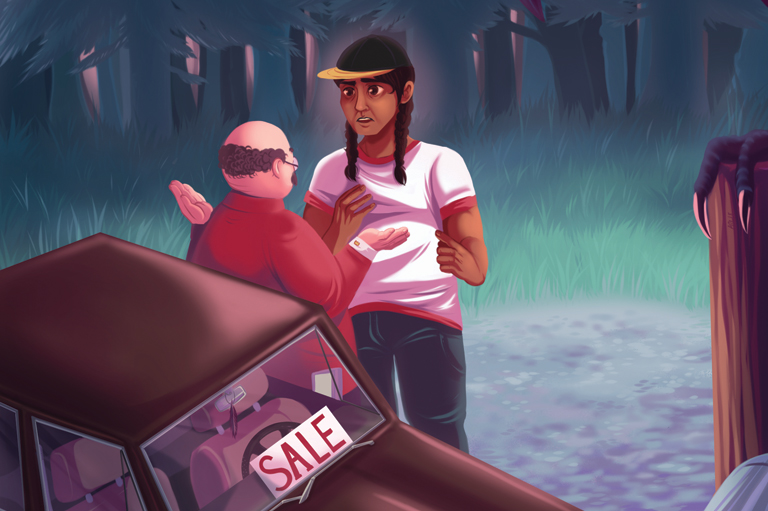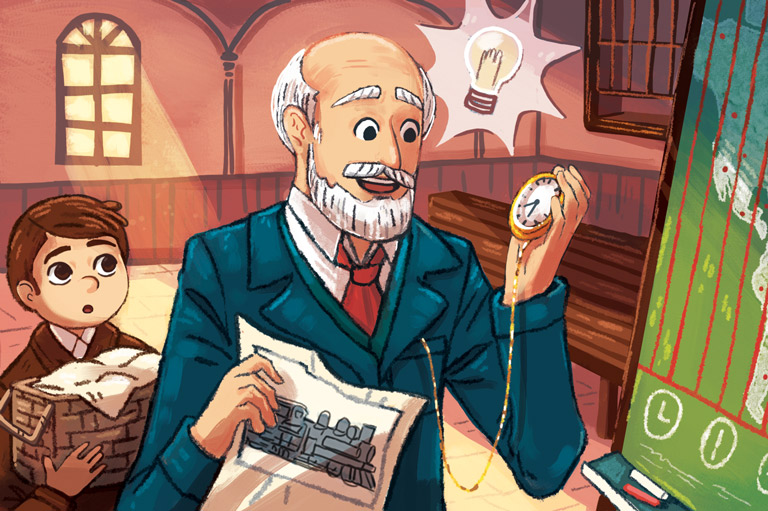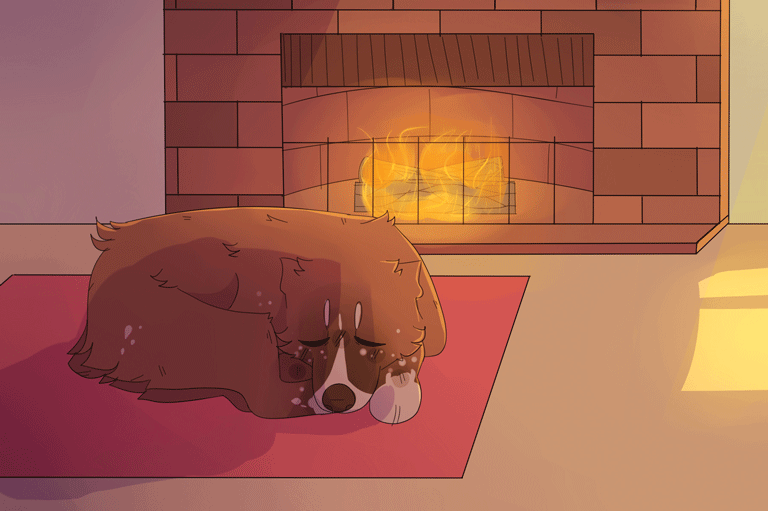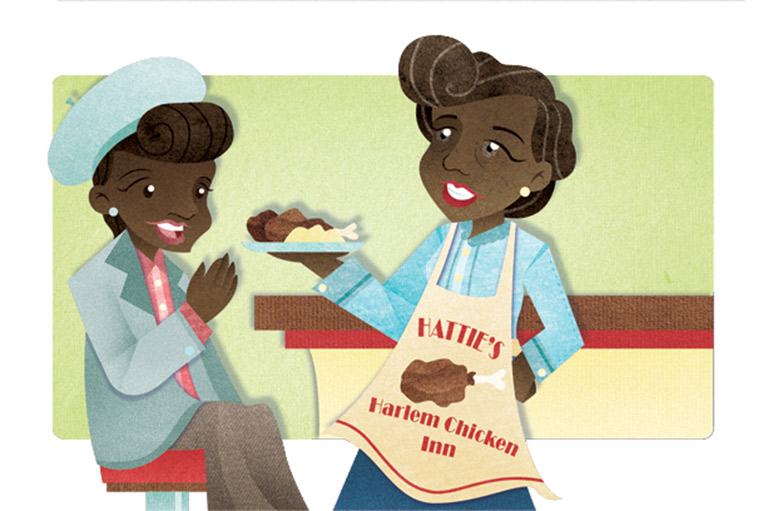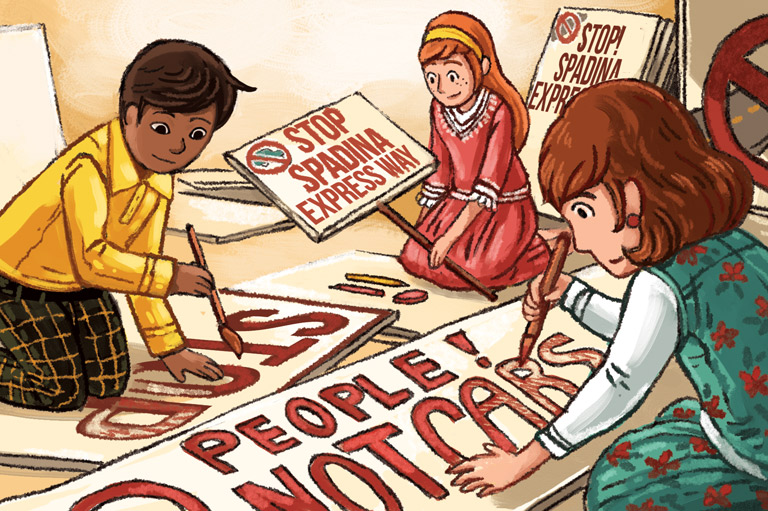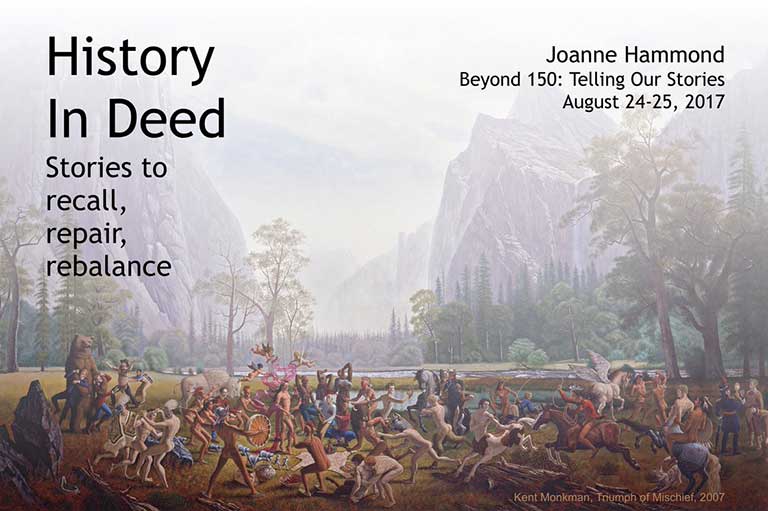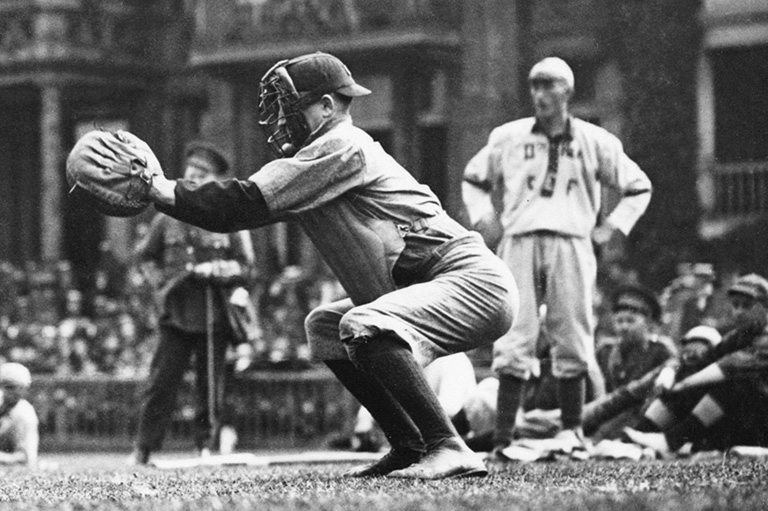Art with Heart
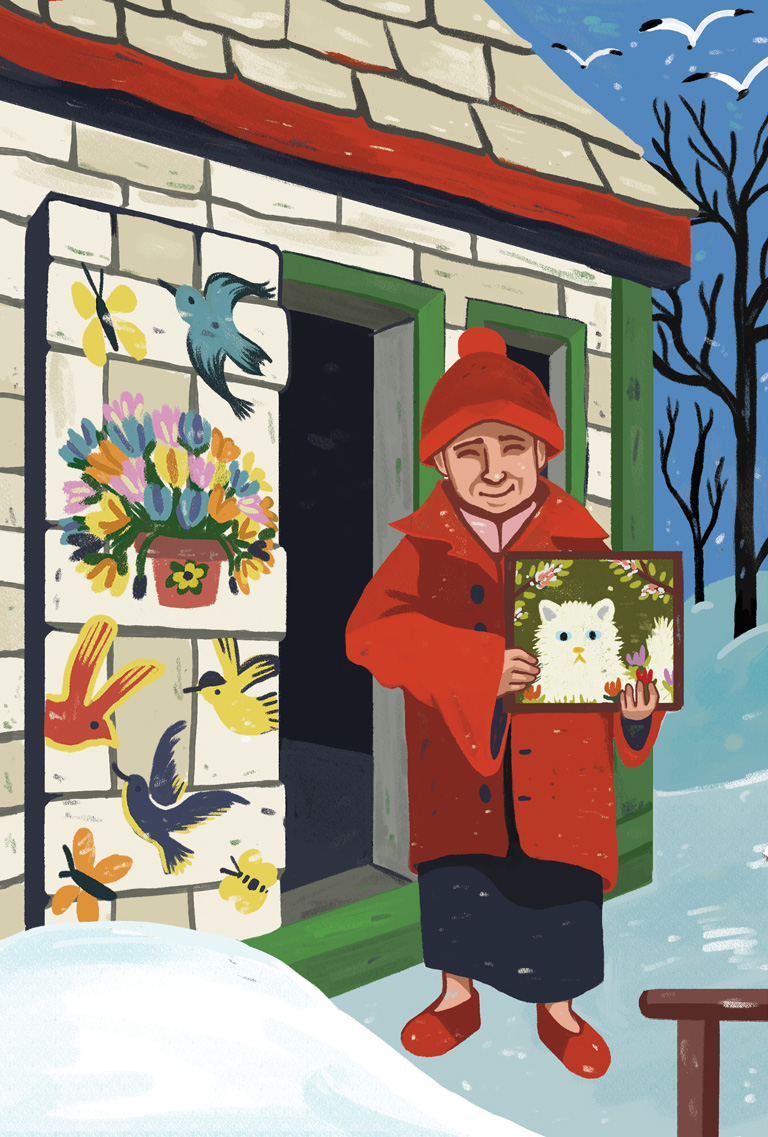
Outside Marshalltown, Nova Scotia, 1964
Barbara and Charlie pedalled their bikes as hard as they could. The Campbell twins never stopped trying to beat each other at whatever they were doing, but they also never got mad about who won.
This time it was Charlie. He pulled up at a tiny white house with the green trim around the windows and door. “You lose,” he shouted. “You have to do the dishes tonight!”
Out of breath, Barbara panted, “Not necessarily. I just said if you won I’d do them. I didn’t say when.”
The bet already forgotten, Charlie pointed to the house’s door. “Look at that! Somebody’s painted flowers all over it.”
Barbara stuck her head around the side. “They’re on the windows, too. I wonder who did them.”
A tall old man in a cap and checked shirt appeared from behind the house. “My wife, that’s who,” the man said.
The twins shot each other a look. They’d heard Everett Lewis could be mean, but maybe that was just the kids at school talking. “Say, can you two use a paintbrush?” the man asked.
“Yes, sir,” Barbara said, remembering her manners. “We helped our dad paint the barn last summer.”
“Well then, follow me.” Around the other side of the house, the twins saw stacks of pressed-wood boards cut into smaller squares and rectangles. “I need you to cover those with the white stuff in that can so Maud has something to work on.” His angular face split into a wide grin. “That wife of mine sure does paint a lot of pictures.”
The twins got busy while Everett started sawing and painting something of his own. The sun shone and neighbours called hello as they walked or drove by. Before long, the boards were done and drying.
Mr. Lewis held up the sign he had made. “Did I spell all the words right? I don’t have much school learning,” he said, looking embarrassed.
“‘Paintings for sale’,” Charlie read. “Yep — that looks right.”
Everett grinned again. “Thank you. I’ll hammer this in around the front. You two go on inside and meet Maud.”
“Will we even fit in there?” Barbara whispered to her brother. “The whole house is smaller than our kitchen at home!”
“Oh, don’t be so snooty,” said Charlie. “People stop in here all the time to buy paintings. And besides, I want to see it for myself. I’ve never met an artist.”
“I heard she just paints trees and boats and houses and stuff. It’s not real art — not like . . .” she tried to think of a famous artist. “Well, not like bowls of fruit and kings riding horses.”
When Charlie knocked, a little voice called, “Come on in! I’m just finishing this cat.”
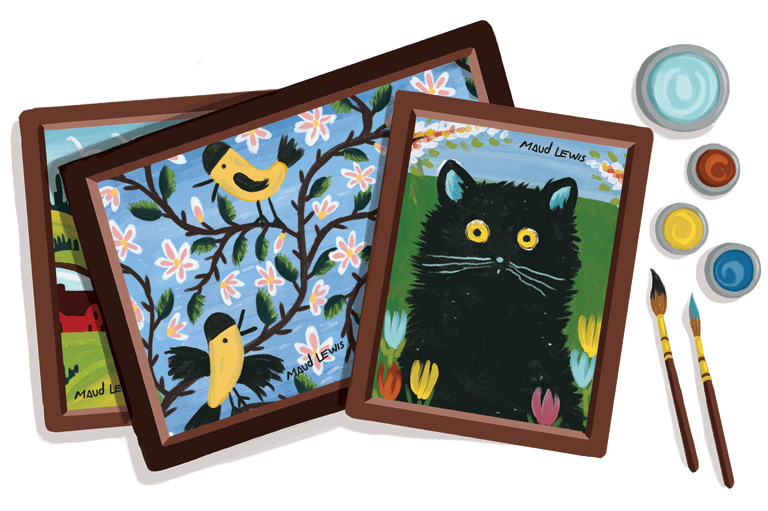
Puzzled, the twins pushed open the brightly painted door and then gasped. The tiny room contained a wood-burning stove, some chairs and a table piled high with painting supplies and newspapers. Splashed all over the yellow walls were cheerful painted flowers, butterflies and birds.
A small woman was dabbing paint on a board like the ones they’d just finished. Chin tucked against her chest, one arm holding the other wrist, she put the finishing touches on a fluffy painted black cat staring out from among painted tulips. Somehow moving both awkwardly and smoothly at once, Maud Lewis quickly dunked her brush in the paint and then added colour just where it was needed.
Dozens of paintings were stacked all around — deer staring out to the ocean, a man rowing a boat, two oxen with decorated harnesses, a horse pulling a sleigh through snow. And everywhere flowers. “Your paintings are beautiful!” Barbara blurted out. “They just make me want to smile.”
“I’ve never travelled far, and I’ve never had lessons,” Mrs. Lewis said softly, “I just paint what I see.”
“Say, that’s the MacCaskills’ barn!” Charlie said, pointing to a picture. “And look, Barbie — it’s the school!”
Mr. Lewis came in and hung up his jacket. “I sure do appreciate your help,” he said to the kids. “Maud, could you spare a painting?”
Maud Lewis beamed. “Of course! Normally I charge four dollars and fifty cents. I’m thinking of putting the price up to five dollars because paints and brushes are getting expensive.”
Barbara’s jaw dropped. “You mean, we can have one of these for our very own?”
The twins studied all the paintings and finally chose one showing a familiar cove near their house. Orange and yellow fall trees stood on green hills, with red and white houses dotted around the shore.
“Thank you!” Charlie called as they said their goodbyes. Outside, he turned to his sister and teased, “I thought you said Mrs. Lewis’s paintings weren’t real art.”
Barbara shook her head. “I don’t know if they’re real art or not, but they sure make me feel happy.”
Calgary, Alberta, 2018
Charlie’s cellphone chirped. “Hey Barbie! Thanks for calling back. I just wondered if you’d heard about the painting.”
From across the country in Halifax, Barbara sighed. “If this is about your idea for a big 65th birthday party for us, I —”
Charlie cut her off. “No — the painting! The one they found in the basement of the old school in Marshalltown. They were going to put it in the yard sale ’til someone noticed it was by Maud Lewis. It just sold for $45,000!”
“Amazing,” Barbara said, shaking her head.
“Aren’t you going to cash in?” Charlie prodded. “Or do you even still have that picture of the cove?”
Barbara looked at the wall of her living room, at the painting with the cheerful houses and bright trees. “You bet I do. And it’s not going anywhere.” Charlie could almost hear the smile in her voice. “It still makes me feel happy.”
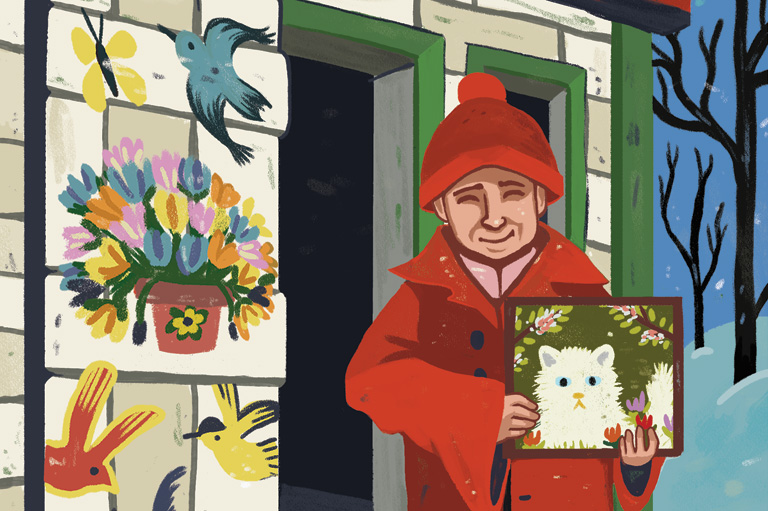
Maud Lewis was born in 1903. She was very small, and her arms and hands never worked quite like everyone else’s. She felt self-conscious about her hunched shoulders and unusually small chin.
But when she painted, the world was full of joy and colour. She first started painting with her mother, making Christmas cards they sold for five cents each.
Maud married Everett in 1938 and moved to his tiny little house near Digby, Nova Scotia, not far down the road from her home in Yarmouth. They were very poor, living off the money they made from selling her paintings for just a few dollars.
When she wasn’t painting things to sell, Maud painted the walls, doors and window of the house itself. The house, which measures just 4.1 by 3.8 metres and never had running water or electricity, is now on display at the Art Gallery of Nova Scotia in Halifax.
Maud wasn’t taken seriously as an artist during her lifetime, although a few people in the art world recognized her talent. She became much more famous after she died in 1970, first being thought of as a folk artist, then simply as a true artist.
In 2016 a movie was made about her, called Maudie.
With 7 uniquely curated newsletters to choose from, we have something for everyone.
We hope you’ll help us continue to share fascinating stories about Canada’s past by making a donation to Canada’s History Society today.
We highlight our nation’s diverse past by telling stories that illuminate the people, places, and events that unite us as Canadians, and by making those stories accessible to everyone through our free online content.
We are a registered charity that depends on contributions from readers like you to share inspiring and informative stories with students and citizens of all ages — award-winning stories written by Canada’s top historians, authors, journalists, and history enthusiasts.
Any amount helps, or better yet, start a monthly donation today. Your support makes all the difference. Thank you!
Themes associated with this article
Advertisement
More fiction features
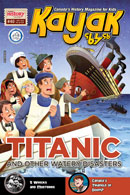
Canada’s History Archive features both English and French versions of Kayak: Canada’s History Magazine for Kids.
Kayak: Canada’s History Magazine for Kids — 3 digital issues per year for as low as $13.99. Tariff-exempt!

